A passion for geology: UH-Hilo grads reflect on work with HVO
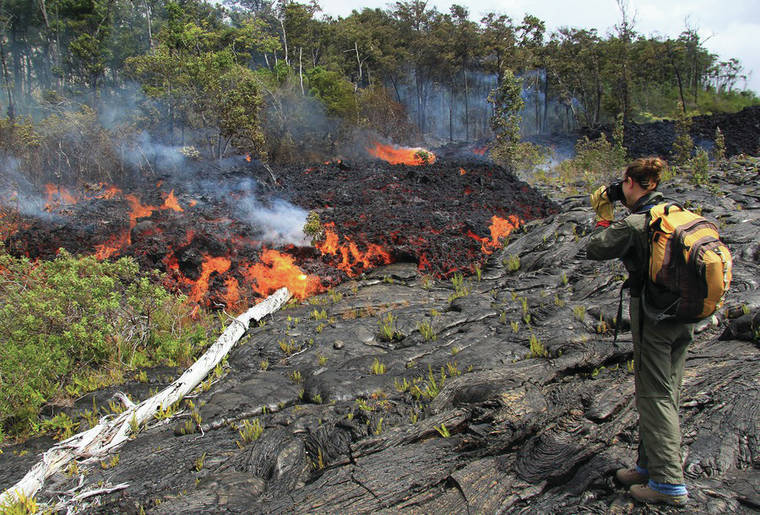
Courtesy of USGS HVO Liliana DeSmither photographs the front of the channelized ʻaʻā flow on June 28, 2016.
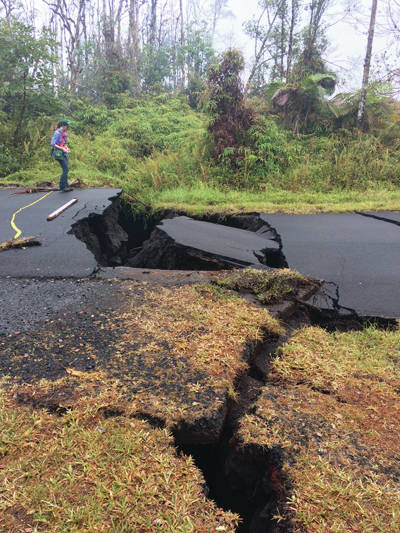
Courtesy of USGS HVO Katie Mulliken monitors lava damage in Leilani Estates during eruption response in 2018.
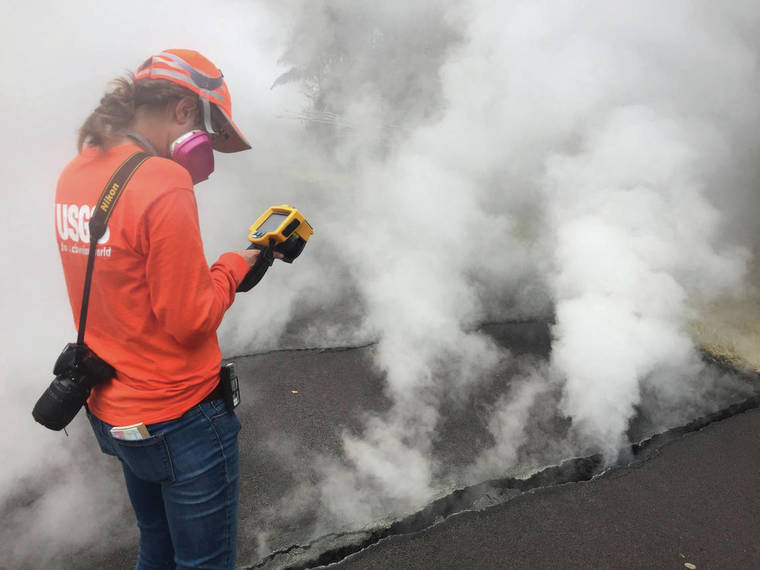
Courtesy of USGS HVO Liliana DeSmither measures the surface temperature of a crack at Nohea Street in the Leilani subdivision with a thermal imaging infrared camera on Wednesday, May 9, 2018.
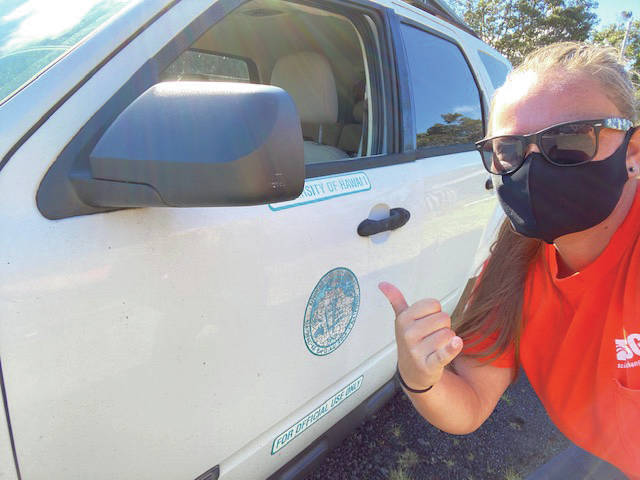
Courtesy of Miki Warren/USGS HVO Miki Warren gives a thumbs-up with RCUH vehicle before collecting gas emissions data in the fall of 2020.
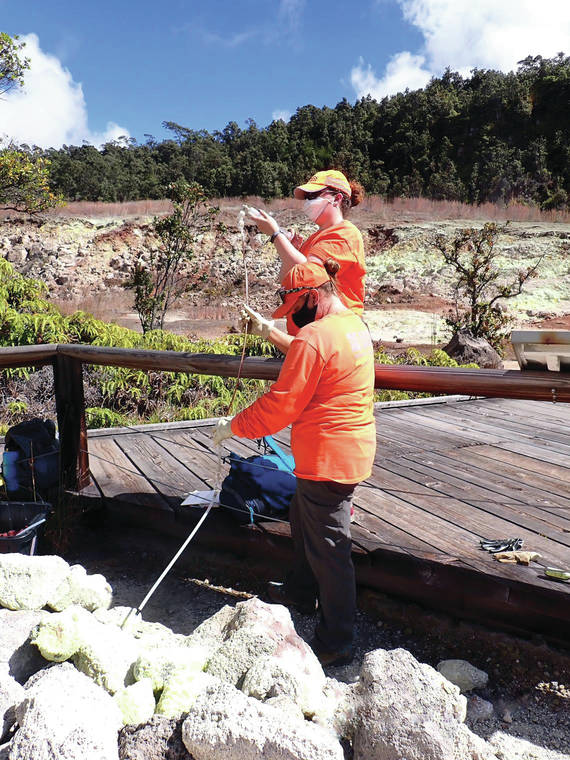
Courtesy of T. Elias/USGS HVO Miki Warren, front, and another HVO gas scientist collect helium samples from fumaroles in the Sulphur Banks, or Ha‘akulamanu area of Hawai‘i Volcanoes National Park on Sept. 30, 2020.
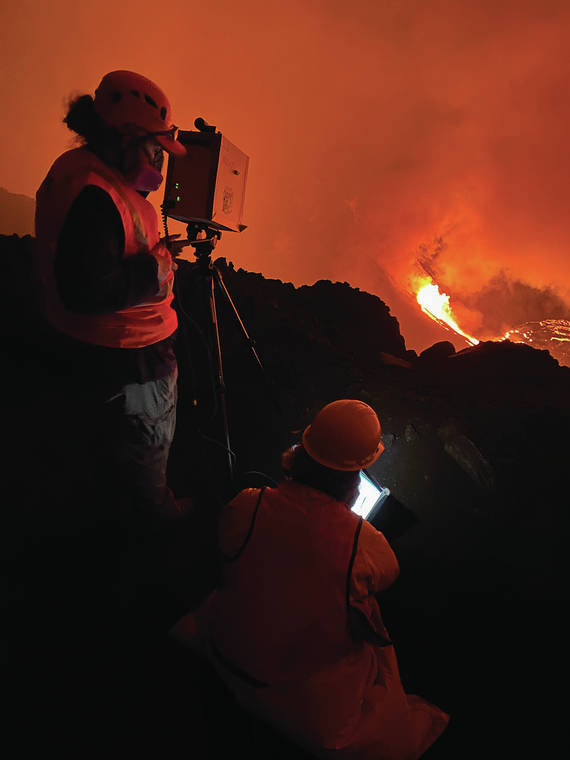
Courtesy of Miki Warren/USGS HVO Gas geochemists, including Miki Warren, collected geochemical spectral data using the light put off from the new lava fountain in Halema’uma’u on Dec. 20, 2020.
Since Kilauea volcano began eruption again in December, three University of Hawaii-Hilo geology alumnae have been working at the forefront of the action.
Since Kilauea volcano began eruption again in December, three University of Hawaii-Hilo geology alumnae have been working at the forefront of the action.
Miki Warren, Liliana DeSmither and Katie Mulliken work for the U.S. Geological Survey’s Hawaiian Volcano Observatory and are currently collecting data and helping to communicate with the public during the eruption.
ADVERTISING
DeSmither, a 2014 graduate, and Mulliken, a 2012 graduate, have been helping to fill in as media coordinators.
“We receive photos and reports from the field and post that information for the public,” Mulliken said. “We push notifications, daily updates and eruption notices to news sources and our website.”
Mulliken and DeSmither also collect data in the field by taking measurements of the lava lake, taking photographs and video, watching eruptive activity to note any changes, and collecting samples of tephra, which are rock fragments and particles ejected by a volcanic eruption.
After working in the field, Mulliken and DeSmither will post graphics, videos, photos and other interactive information on the HVO website for the public.
Warren’s fieldwork specialty is gas geochemistry. She assists HVO scientists in collecting information about the types and amounts of volcanic gases that are emitted by the volcano, both during eruptions and periods of inactivity.
“I go out pretty much any day that has good wind and weather,” Warren said. “I take a Fourier transform infrared spectroscopy on a vehicle to collect geochemical spectral data and identify the gasses that create vog.”
FTIR is a tool that’s used to measure the relative abundance of different gases, including sulfur dioxide, carbon dioxide, hydrogen chloride, hydrogen fluoride, carbon monoxide and water vapor.
During the beginning of the eruption, the three scientists were on the clock 24/7 while information was rapidly changing. Although work has been less demanding over time, geology crews are going out to monitor the activity every hour.
“We’ve established a routine, and each team will spend six hours in the field at a time,” DeSmither said. “After we finish there, we come back and have other responsibilities in communications or in the lab.”
While the geologists graduated years apart, they each had similar experiences at UH-Hilo that helped them grow their passions for geology.
DeSmither grew up on Hawaii Island and was very familiar with its volcanoes and participated in volcanology programs.
Although she was interested in geology, DeSmither did not know she wanted to pursue the science until taking a class with geology professor Steve Lundblad.
“I was able to talk with so many people at the Center of the Study of Active Volcanoes, and great opportunities came to me from the program,” DeSmither said. “I had many chances to work on different projects, and it got me passionate about doing this work.”
CSAV is a training and outreach program that provides information about volcanic and natural hazards that occur in Hawaii and worldwide. The program has been operating since 1989, and is a cooperative program of UH-Hilo, HVO and the University of Hawaii at Manoa.
Warren graduated from the UH-Hilo in 2018 and fell in love with geology after taking her first class with Ken Hon, who was an emeritus professor of Geology.
“The geology program at UH-Hilo allows for volunteer opportunities with the CSAV, which is such a great way to get hands-on experience,” Warren said. “I am still so incredibly grateful for the opportunities I was able to have as a student.”
Mulliken grew up in Volcano and frequently visited Hawaii Volcanoes Natioal Park.
“Kilauea was close by, and we would always go hiking and check out the crater anytime someone visited,” Mulliken said. “It wasn’t until I took geology classes at UH that I discovered how fascinating the volcano truly was.”
Darcy Bevens is an educational specialist at CSAV and has seen the three geologists grow as students and thrive in their professional careers.
“I’ve known all of these guys for so many years ,and it has been such a pleasure to watch them grow in their careers,” Bevens said. “They are so polished and professional. They make us proud.”
Bevens said the three geologists were hired at HVO through a UH-Hilo Cooperative Research Agreement, established by the late U.S. Sen. Daniel K. Inouye in 1998 to promote research collaboration between HVO and UH-Hilo. The grant is managed by CSAV.
During Kilauea’s 2018 lower East Rift Zone eruption, Mulliken was working as a geologist for the State of Alaska Division of Geological &Geophysical Surveys and the Alaska Volcano Observatory.
“During big eruptions like Kilauea’s 2018 eruption, other volcano observatories in the U.S. send personnel to help out with the monitoring,” Mulliken said “So, I was one of many staff from other observatories that was sent here to Hawaii to help out with the 2018 eruption response.”
DeSmither held the same position and worked in the field with HVO during the 2018 eruption. Warren, who was not yet graduated, was able to volunteer and actively learn through the experience.
“My advice to people in the geology program is always to volunteer as much as they can with as many groups as they can,” Warren said. “Because I got so much experience, I was able to find exactly what I wanted to do.”
Before the eruption on Dec. 20, the geologists held the same jobs they do today, but there was less to do.
“Because of COVID-19, we were working from home, and on the rare occasion, I would be able to go out in the field,” Warren said. “I much prefer being out of the office.”
David Phillips graduated from UH-Hilo in 1996 and was the acting scientist-in-charge at HVO when Kilauea surprised everyone in December with an eruption.
“We’ve all been on call to watch what Kilauea’s ‘new normal’ would be. We noticed an increase in activity and were planning to increase the alert level the day after the eruption,” Phillips said. “There were no typical precursors, so we definitely were not expecting the eruption that night.”
Phillips has been working closely with the three alumnae as they all actively respond to the eruption.
“It has been a fantastic experience. Everyone is amazingly talented, smart and energetic. I learn much more from them than they do from me,” Phillips said. “I have such confidence in the work they’ve been doing, and would be lost without them.”
On Feb. 1, Hon was announced as HVO’s new scientist-in-charge, with Phillips filling the roll as deputy scientist-in-charge.
“We’re all really excited that Ken Hon is the new scientist-in-charge,” Mulliken said. “We have all had him as a professor at one point, so this will be a really exciting time for us.”
Although they are working at the volcano every day, the geologists are still surprised by their jobs and what they have been able to accomplish.
“I’m still so amazed by everything I am able to do right now,” Warren said. “Everyday, I wake up and I’m just excited to go do my job.”
“I couldn’t imagine doing anything else,” DeSmither said. “Even after all of these opportunities, it’s still an incredible experience.”
Email Kelsey Walling at kwalling@hawaiitribune-herald.com


